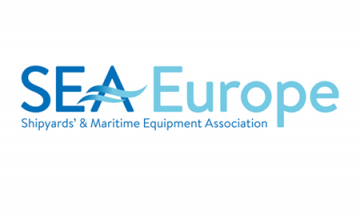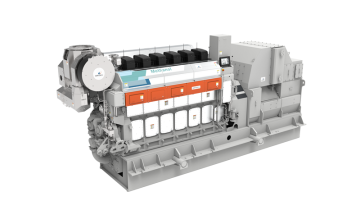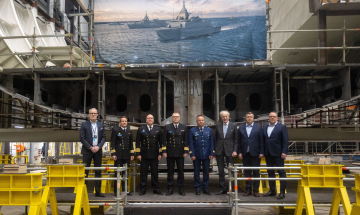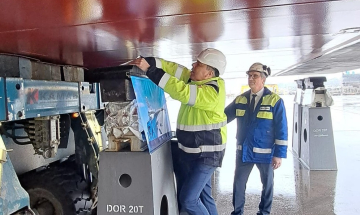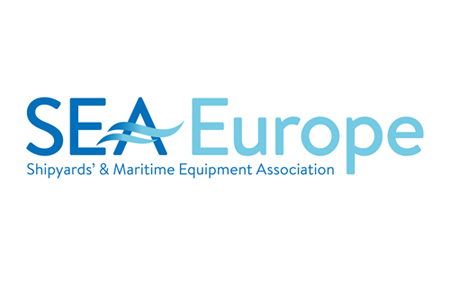
FIT FOR 55 Promising potential for climate change BUT more needed to make it a sustainable economic growth for the maritime technology sector
On 7 December, SEA Europe issued position papers on the “inclusion of shipping into EU ETS”, on “FuelEU Maritime” and on “Carbon Border Adjustment Mechanism”, all part of the “Fit-for-55” legislative package.
SEA Europe fully supports the goals of the “Fit-for-55” legislative package, i.e. a strategy for climate change and for zero-emission waterborne transport by latest 2050. SEA Europe firmly believes that this legislative package – as the European Green Deal – will offer stimulating opportunities for Europe’s shipyards and maritime equipment industry (known as “maritime technology sector”). However, at the same time SEA Europe believes that more efforts will be required to turn the EU’s ambitions on climate change into true economic opportunities as well, especially for Europe’s maritime technology sector.
With Covid-19, Asia’s competitive distortions have only but aggravated, to the detriment of Europe’s maritime technology sector. Almost all recent orders for newbuilt vessels, including for green vessels, have been placed in South Korea or China, also by European shipowners, due to low prices offered by Asian yards benefitting from past and present state support. Hence, any additional competitive distortions will no doubt result in a loss of the remaining part of Europe’s maritime technology sector, at a time that Europe aims at implementing the European Green Deal, also for the waterborne (transport) sector. Therefore, specific policy actions will be needed to enable Europe’s shipyards and maritime equipment industry to reap the promising benefits from the European Green Deal and the Fit-for-55 legislative package.
In general, SEA Europe recalls that there is no “one-size-fits-all” solution for the transformation of waterborne transport towards a zero-emission mode of transport, due to the large variety of ship types and ship trades, and that the optimal pathways towards rapid emission reduction, zero-emission ships and climate neutrality are by no means straightforward. Therefore, SEA Europe calls to research, develop, financially support, and legally ascertain all options for clean technologies, alternative fuels and their optimal integration onboard vessels. Equally, SEA Europe insists that any legislation and policy actions on zero-emission waterborne transport is technology and fuel neutral (thus stimulate flexibility amongst technologies and fuels) as well as goal-based (thus refraining from imposing or prescribing specific technological solutions or alternative fuels).
On the inclusion of shipping into EU ETS, SEA Europe calls for the entire reinvestment of the revenues generated from this inclusion as well as from the penalties for non-compliance under FuelEU Maritime in the European maritime sector, including the maritime technology sector. In this respect, whilst underlining the need for continued financial support for RD&I to achieve zero emission waterborne transport, SEA Europe stresses that revenues from EU ETS should primarily support the onboard deployment of implementable energy-saving technologies and zero-emission solutions as well as the deployment of green infrastructure. Furthermore, these revenues should also financially stimulate first movers. Therefore, SEA Europe calls to primarily direct the scope of the use of the revenues from the EU ETS to achieve the EUGD 55% reduction goals by 2030 and ultimately to reach climate neutrality by 2050.
On the inclusion of shipping into EU ETS, SEA Europe also recalls that the technological development of certain technologies (such as fuel cells), the use of electricity, or onboard carbon capture technology must necessarily and primarily first be demonstrated on small ships, before being scaled up to more mature and energy-efficient technologies applicable for larger ships as well. SEA Europe therefore calls to allocate the financial support under the EU ETS also to ships falling outside the scope of the EU ETS Directive and the FuelEU Maritime Regulation, in other words to ships not included in the MRV regulation (including those below 5000 GT).
On FuelEU Maritime, SEA Europe is concerned that this legislative proposal does not actually aim at reducing emissions but rather focuses on the use of some fuels. If so, the proposal cannot be considered as technology-neutral and, in doing so, the EU may risk losing the opportunity to reduce CO2 emissions through other fuel options, such as synthetic (drop-in) fuels, which can offer a significant reduction potential and be utilized with minimal or moderate retrofitting of ships, at least as a transitional midterm option. SEA Europe therefore recalls that current existing energy converters, such as internal combustion engines, will still play a significant role in the decarbonization of waterborne transport, if utilized with climate neutral synthetic fuels and/or climate neutral enabling technologies (such as the use of wind-assisted propulsion means, the use of Carbon Capture Storage (CCS) for onboard application or in combination with the production of new fuels as an alternative zero-carbon energy source).
On FuelEU Maritime, SEA Europe, also recalls that the availability of sustainable alternative fuels will not exclude competition on sustainable fuels in the future and SEA Europe therefore calls for more emphasize on the most energy efficient technology because sustainable fuels, even if produced from renewable sources, will be done at a higher cost than current conventional fuels.
Furthermore, SEA Europe underlines the need to pay attention to the training, upskilling and/or reskilling of seafarers (operators) as well as workers across the maritime technology sector. The transformation of waterborne transport towards a zero-emission mode of transport will indeed necessitate that these workers get acquainted with, operate, install, repair, and maintain new propulsion systems, zero-emission technologies and sustainable fuels. For this reason, SEA Europe is coordinating the so-called “Shipbuilding and Maritime Technology Pact for Skills”, i.e., a large-scale partnership where the main shipbuilding groups, SMEs, education providers, public bodies and trade unions are committed to collectively address skills gaps and needs in the maritime technology industry.
Finally, on the “Carbon Border Adjustment Mechanism” (CBAM), SEA Europe supports the objective of preventing carbon leakage whilst expressing concerns on the proposal’s unintended negative impacts on the competitiveness of Europe’s Maritime Technology Sector that would occur in the absence of appropriate mitigating measures
“Without a holistic and goal-based approach and without technological and fuel neutrality, the road towards zero-emission waterborne transport may be seriously hampered, whilst promising opportunities for the maritime (technology) sector in delivering real emission reductions may be missed”, says Christophe Tytgat, SEA Europe’s Secretary General. “A successful European Green Deal and Fit-for-55 package should stimulate investments in the production of new green ships (newbuilding) as well as in the integration of green technologies and sustainable fuels onboard existing vessels (retrofitting of ships) and should also optimize the business case for sustainable alternative fuels, whilst addressing the distortion of competitiveness between European and Asian shipyards. Without reducing the well-known unfair price gap with Asia, or at least without stimulating innovative green shipping in Europe, European shipyards and their supply chain will not be able to win the green competition from Asia and thus to deliver on the goals of the European Green Deal”, Mr. Tytgat concludes.
Background Note:
SEA Europe represents close to 100% of the European shipbuilding industry in 16 nations, encompassing the production, maintenance, repair and conversion of all types of ships and floating structures, commercial as well as naval, including the full supply chain with the various producers of maritime systems, equipment material, and services.

